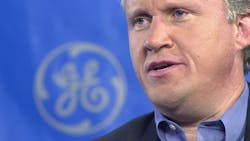GE’s Surprise $15 Billion Shortfall Was 14 Years in the Making
The trouble at General Electric Co. started decades ago when a hole formed inside its sprawling financial unit.
The hole grew into a $15 billion shortfall in insurance reserves, disclosed last week. It’s prompted a Securities and Exchange Commission investigation, called into question the oversight of GE leadership, pushed down the share price, and shocked investors who were asking Wednesday how this icon of American capitalism could allow the situation to deteriorate to this point.
“It sure seems that previous management had a rosy view,” said Scott Davis, an analyst with Melius Research in New York. “There seemed to be no effort on their part to get ahead of the liability. I find it very hard to believe that mysteriously overnight GE found problems they didn’t know existed.”
A representative for Jeffrey Immelt, who was GE’s chief executive officer from 2001 to 2017, declined to comment.
In 2004, GE spun out an insurance unit, Genworth Financial Inc., through a stock offering. The move was important to the parent company. It helped eliminate one of the biggest drags on GE’s earnings.
IPO Snag
At the time, advisers told GE the share sale could run into obstacles. Some Genworth businesses were too weak for investors’ tastes. GE would need to backstop them. GE agreed to reinsure some of Genworth’s long-term-care insurance.
The company, then run by Immelt, raised $3.53 billion in its first Genworth share sale. The insurer’s stock rose 67% by the time GE sold the last of its stake for $2.8 billion in 2006.
Long-term-care insurance is a business that’s gotten tougher over the years. Policyholders are living longer. Medical costs have risen. Some insurance companies have quit selling the product altogether. Genworth has taken writedowns to shore up the business with cash reserves. GE is certainly not the first company to get its assumptions wrong, and the insurance policies date as far back as the 1980s. No new contracts were written after 2006.
But GE didn’t change its assumptions in a big way — a decision that baffled industry veterans.
Calculation Error
Genworth announced a revamp of its actuarial assumptions in 2014 after a calculation error, leading to a $1.2 billion loss for the year. It was a warning sign to the industry that long-term-care insurance policies were more toxic than initially thought. It also captured the attention of people familiar with the GE reinsurance contracts. They asked why Genworth was revising its assumptions while executives at the financial conglomerate mostly left theirs alone.
Boston-based GE added at least $1 billion to its reserves over five years to mitigate some operating losses, according to a July report by ratings firm A.M. Best. Over a decade, the company contributed about $4 billion, said a person familiar with the situation.
Some employees were aware that long-term-care insurance was in bad shape. And even as it sold the bulk of its finance business, executives resisted selling reinsurance assets, even when bankers encouraged them.
Doing so would have forced GE to book a huge charge to reflect a drop in value, according to people familiar with the situation who asked for anonymity because they weren’t authorized to speak. That was an indication that the business was worth less than what GE reported to investors, the people said.
Suspend Dividends
GE disclosed last year that it was reviewing the long-term-care business and would suspend dividends paid to the parent company. In November, while the process was still underway, chief financial officer Jamie Miller said the company would likely take a charge of more than $3 billion.
When GE disclosed final results last week, Wall Street was shocked by the magnitude of the financial hit — a $6.2 billion charge against earnings and $15 billion to be put into reserves over seven years. On a Jan. 16 conference call with management, one analyst asked whether GE still had faith in its auditor, KPMG, while Jeff Sprague of Vertical Research Partners mused, “It’s hard to imagine a $15 billion problem materialized in the course of the year.”
Ryan Zanin, GE Capital’s chief risk officer, blamed increasing claims from aging policyholders in the past two years.
GE CEO John Flannery said in a statement last week that a charge of this size was “deeply disappointing” at a time when the company was trying to move forward. Flannery has been CEO only since August.
GE declined to comment beyond its previous public comments.
By Sonali Basak, Katherine Chiglinsky and Richard Clough, with assistance from Noah Buhayar.
About the Author
Bloomberg
Licensed content from Bloomberg, copyright 2016.
